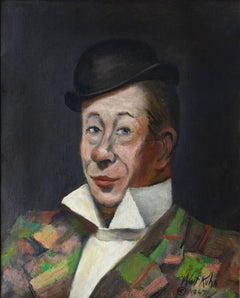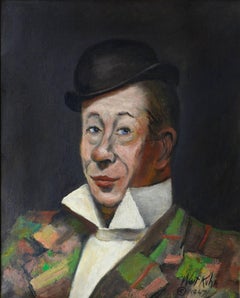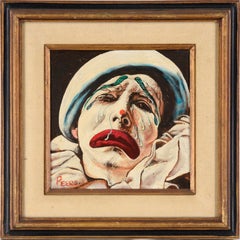Walt Kuhn Figurative Paintings
American, 1880-1949
Walt Kuhn (1877-1949) He was associated with "The Eight" and with Arthur B. Davies, was a the key figure in forming the American Association of painters and Sculptors that organized the Armory Show of 1913 that introduced modernist European art to America. Kuhn was executive secretary of the Association and traveled abroad to select entries for the Armory Show. He was strongly influenced by Cezanne which is evident in many of his paintings. Like Cezanne, he destroyed many of his paintings, keeping only about a dozen a year.
He was born in Brooklyn, New York and in 1900 first used the name Walt when illustrating magazines in San Francisco. He studied at the Royal Academy in Munich from 1901 to 1903 and returned to New York where he worked as a cartoonist and magazine illustrator.
In the permanent collection of most major museums worldwide. His record price for a painting to date is 1.6 Million dollars.(Biography provided by Lynda Anderson Galleries)
to
2
2
2
Overall Height
to
Overall Width
to
1
1
2
2
2
2
2
2
12
419
225
205
102
2
2
Artist: Walt Kuhn
Portrait of Bert Lahr as Burlesque Clown - The Cowardly Lion in the Wizard of Oz
By Walt Kuhn
Located in Miami, FL
Bert Lahr shined in the role of The Cowardly Lion in the Wizard of OZ. Here he is depicted in his comedian's costume which he wears while staring in Jea...
Category
1940s American Impressionist Walt Kuhn Figurative Paintings
Materials
Oil
Portrait of Bert Lahr - Circus Performer - Modernism
By Walt Kuhn
Located in Miami, FL
A recent Kuhn Circus Performer sold for $312,000 at Bonhams, NY
Bert Lahr shined in the role of The Cowardly Lion in the Wizard of OZ. Here he is depict...
Category
1940s American Modern Walt Kuhn Figurative Paintings
Materials
Oil
Related Items
Crying Clown Portrait in Oil on Canvas
Located in Soquel, CA
Crying Clown Portrait in Oil on Canvas
Portrait of a sad clown by San Francisco artist John Peers (American, 1922-2009). This portrait is closely fra...
Category
1970s American Modern Walt Kuhn Figurative Paintings
Materials
Canvas, Oil
At Doug's Place
By Lu Haskew
Located in Loveland, CO
At Doug's Place by Lu Haskew
Oil 12x10" image size
Plein Air artists sit by a river discussing on break from the day of painting.
ABOUT THE ARTIST:
Lu considered it a must to work...
Category
Early 2000s American Impressionist Walt Kuhn Figurative Paintings
Materials
Canvas, Oil
"Rhythmic Silk, " Oil painting
By Suchitra Bhosle
Located in Denver, CO
Suchitra Bhosle's "Rhythmic Silk" is an original, handmade oil painting that depicts a dark-haired woman on a red chair with a red silk top and flowing white skirt.
About the Artis...
Category
2010s American Impressionist Walt Kuhn Figurative Paintings
Materials
Board, Oil
John Fishing
By Lu Haskew
Located in Loveland, CO
John Fishing by Lu Haskew
Oil 30x24" image size
Figurative Portrait of a man with fishing pole.
ABOUT THE ARTIST:
Lu considered it a must to work with live models once or twice...
Category
Early 2000s American Impressionist Walt Kuhn Figurative Paintings
Materials
Oil
Oil Painting by Well Known Cartoonist and Illustrator Upper East Side, Manhattan
By Sandy Huffaker
Located in Surfside, FL
An Upper East Side of Manhattan New York city scene of bald guy reading newspaper on bench with East River and tugboat in background.
The 1970s were the “glory days,” Huffaker says, for himself and a stable of talented illustrators whose work routinely found itself on the covers of the nation’s premier newsmagazines and in the pages of The New York Times. For the better part of that decade, Huffaker was among an elite breed of commercial artists—his hero and fellow Southerner Jack Davis, the legendary Mad Magazine illustrator, among them—working during a remarkable period when art directors routinely turned to illustration to give comic relief to the country’s deeply serious and dark problems. From civil rights and the women’s movement to Vietnam and Watergate, the gas crisis and inflation to the rise of Jimmy Carter, Huffaker mined a deep well of material ripe for his brand of visual wit and caustic satire. He sent his portfolio to children's book illustrator Maurice Sendak, the legendary “Where The Wild Things Are” illustrator to gauge his prospects, and when Sendak replied, “C’mon up, you’ll do all right,”
SELECT HONORS:
2 Page-One Awards (from the New York Newspaper Guild), for work in Fortune Magazine and Sports Illustrated.
Nominated 3 times for Cartoonist-of-the-Year by the National Cartoonists Society (illustration category).
Desi Award of Excellence (Graphic Design Magazine).
20 Award of Merit citations from the Society of Illustrators.
One-man show, Society of Illustrators.
Illustrators 22 - annual national exhibition for the Society of Illustrators.
SELECT MAGAZINE COVERS
Time Magazine (6),
Sports Illustrated (2),
Business Week (12),
Forbes,
Saturday Review,
New York Times Sunday Magazine,
The New Republic,
Family Weekly,
Madison Avenue,
New York Daily News Sunday Magazine (2),
Junior Scholastic,
ACLU,
The Nation , and more
EDUCATION BA, University of Alabama. Attended Pratt Graphic Center and The Art Students League, New York City.
BOOKS WRITTEN AND ILLUSTRATED The Dispensible Man (M. Evans and Co.) and The Bald Book (M. Evans and Co.) BOOKS ILLUSTRATED White Is (Grove Press), The Begatting of a President (Ballantine Books), The Biggest Sneeze (Harper-Collins), H. Phillip Birdsong's ESP (Young Scott Books), Kids Letters to President Reagan (M. Evans), The Worlds Greatest Left-Handers (M. Evans), Does My Room Come Alive at Night (HarperCollins), The Man With Big Ears (HarperCollins), Jake Snake's Race (HarperCollins), and more
POLITICAL CARTOONING Political cartoonist at The News and Obsever in Raleigh, NC and syndicated during the early 70's. Today, syndicated in 750 publications 3-times a week with Cagle Cartoons.
FINE ART SHOWS Allied Artists of America, Salmagundi Club, Phillips Mill Annual (honorable mention), New Hope Shad Festival (grand Prize), Hunter Museum in Chattanooga ( one -man career retrospective), Santa Fe public library (one--man), Rosenfeld Gallery (Philadelphia), Potter...
Category
20th Century American Modern Walt Kuhn Figurative Paintings
Materials
Canvas, Oil
Portrait of Artist's Wife with Fruit, 1945 American Modern Oil Painting
By Hayes Lyon
Located in Denver, CO
Untitled (Portrait of Bessy Lyon, Artist Wife) is an oil on canvas painting by Hayes Lyon (1901-1987) from 1945. Presented in a wood frame, outer dimensions measure 35 ¼ x 29 ¼ x 1 ¾ inches. Image size is 30 x 24 inches.
About the Artist:
A native of Athol, Kansas, Lyon is primarily associated with Colorado. After several summer vacations at the Boulder Chautauqua and at Manitou near Colorado Springs, his family relocated in 1920 to Boulder where his father had a lumber business. Nine years later they settled in Denver where his father owned the Acme Lumber Company. To comply with his desire for his son’s financial self-reliance, Lyon graduated from the University of Colorado at Boulder in 1931 with a B.A. degree in economics.
But shortly thereafter he returned to his first love – art – that ultimately became his career. His interest in the arts was nurtured by his mother, herself a talented amateur artist, and by two of his aunts who served as role models. Beginning in 1932, he pursued a five-year course of study at the Chappell School of Art in Denver which by then had become part of the University of Denver. During his time at the school he studied with John E. Thompson and Santa Fe artist, Józef Bakoś. He also met two other Santa Fe-based artists, Willard Nash and B.J.O. Nordfeldt, when they exhibited at Chappell House, then the home of the Denver Art Museum. Lyon likewise attended the Cooke-Daniels Lecture Series there on the arts in the 1930s.
Following graduation with a B.F.A. degree from the University of Denver in 1937, he studied privately for about a year with Andrew Dasburg in Taos, New Mexico, that redirected his attention to the rugged Rocky Mountain landscape, which he saw with directness and painted with an economy of means. His canvas, Winter Vista, done following his study with Dasburg, received the Edward J. Yetter Memorial Prize at the 45th Annual Exhibition of the Denver Art Museum in 1939. The painting was reproduced in the September 1939 issue of the Magazine of Art (Washington, DC). That same year his painting, Mount Evans, was included as one of Colorado’s entries in the American Art Today Pavilion at the 1939 World’s Fair in New York.
The money he received from the Yetter Prize financed his trip to Mexico City and Guadalajara in 1939 to see firsthand the frescoes of José Clemente Orozco and Diego Rivera and the easel paintings of David Alfaro Siqueiros. Their work was admired by many Americans who participated in the WPA-era mural projects in the United States in the 1930s and early 1940s. The economic fallout from the Great Depression affecting many American artists at the time likewise resulted in Lyon’s participation in the Colorado Art Project, part of the WPA’s national program. Under its auspices he produced three murals in 1940 about the pioneer era of Fort Lupton, Colorado, which were installed in the auditorium of the local high school. Covering 367 square feet of wall space, one of the murals – Behold the West (the largest one) – incorporates the old fort for which the town is named. Before Lyon painted the murals, the students at Fort Lupton High School researched the history of their community and contributed to their cost, facilitating the murals’ allocation to their school under the Colorado Art Project.
In the early 1940s Lyon shifted his focus to two new subjects – bathers, and canyons with conifers – reflecting his ongoing search for personal artistic growth. However, his reliance on structure to create form in his paintings and works on paper alienated some of his longtime followers. Nonetheless, his painting Conifers and Canyons won recognition at the 47th Annual Exhibition at the Denver Art Museum. The watercolor version of the piece was among three hundred works in that medium selected by John Marin, Charles Burchfield and Eliot O’Hara from a national competition held by the Section of Fine Arts (Federal Works Agency) and shown at the National Gallery of Art in Washington, DC, in 1941. Later that year Lyon spent time in California where he saw Orozco’s Prometheus, influencing him to increase his range of originality and expression.
In 1942 Lyon enlisted in the U.S. Army, spending almost three years in the Mediterranean Theater – Africa and Italy – preparing camouflage operations and scale models of proposed landing sites. He used his free time in Italy to expand his artistic vocabulary by seeing cultural masterpieces in Rome, Florence, Siena and Milan, and through his extensive contact with Giorgio de Chirico, founder of the scuola metafisica art movement, and Gino Severini, a leading member of the Futurist movement. Because of Lyon’s low army rank and pay, de Chirico did a small watercolor for him signing it, "For Mr. Lyon; G de Chirico, 1944." Lyon often visited de Chirico and his wife, Isa, at their apartment near the Spanish Steps in Rome.
Following his Army discharge in 1945 fellow Kansas native, Ward Lockwood, invited him to join the Art Department at the University of Texas at Austin where he taught painting from 1946 to 1951. During this period some of Lyon’s work employed the palette of the School of Paris which he had seen while stationed in Europe, while other paintings had a certain flatness found in some of Lockwood’s work from the 1930s. From 1951 to 1953 he was affiliated with the Lower Colorado River Authority in Austin as an illustrator and editor of the employee magazine.
In 1953, following time spent in Mexico, he returned to Denver, working as an illustrator at Lowry Air Force Base until retirement in 1961. During that time he did little of his own art because he also was designing and building a home in Arvada, Colorado, and re-establishing himself in the Denver art community after a decade-long absence. His painting, Autumn Aspens (1953-present location unknown) illustrates his experimentation with abstraction.
In the early 1960s he began painting from memory that continued until the steadily degenerative effects of Alzheimer’s disease took their toll a decade later. He depicted scenes from his wartime European sojourn and from his early adulthood. The latter include Souvenir of Boulder (1962), a nostalgic return to his boyhood home in Boulder; and Holly Mayer and Friends, a painting of Glenn Miller and his musicians, inspired by Lyon’s first encounter with jazz in Boulder in the 1920s. His lifelong passion for vintage cars and automobile racing...
Category
1940s American Modern Walt Kuhn Figurative Paintings
Materials
Oil, Canvas
H 35.25 in W 29.25 in D 1.75 in
Gratitude
By Suchitra Bhosle
Located in Denver, CO
Lone figure with red
Category
2010s American Impressionist Walt Kuhn Figurative Paintings
Materials
Oil
"Undone, " Oil Painting
Located in Denver, CO
Clyde Steadman's "Undone" is an original, handmade oil painting that depicts an impasto portrait.
Category
2010s American Impressionist Walt Kuhn Figurative Paintings
Materials
Oil
Portrait of Kevin's playmate
By Donald S. Vogel
Located in Dallas, TX
Donald Vogel’s paintings reflect his interest in seeking beauty in life and in sharing pleasure with his viewers. Vogel entreats us to "rejoice and celebrate each new day, knowing it...
Category
Mid-20th Century American Modern Walt Kuhn Figurative Paintings
Materials
Panel, Oil
Portrait of a Child
By Will Barnet
Located in Buffalo, NY
An original modern abstract portrait of a child by American artist Will Barnet. The work has a letter of provenance from the artist's wife. The i...
Category
1930s American Modern Walt Kuhn Figurative Paintings
Materials
Wood, Oil
Yellow Symphony #1
Located in Bogotá, Bogotá
This horizontal painting on canvas contains several layers of color, with textures and transparencies, representing a dreamlike scene where fantastic animals and humans in yellow and...
Category
2010s American Modern Walt Kuhn Figurative Paintings
Materials
Oil, Canvas
Modernist Oil Painting 1940s, Judaica Hasidic Rabbi in Jerusalem
By Emanuel Glicenstein Romano
Located in Surfside, FL
Genre: Portrait
Subject: Landscape
Medium: Oil
Surface: Board
Country: United States
EMANUEL ROMANO
Rome, Italy, b. 1897, d. 1984
Emanuel Glicenstein Romano was born in Rome, September 23, 1897.
His father Henryk Glicenstein was a sculptor and was living in Rome with his wife Helena (born Hirszenberg) when Emanuel was born. His father obtained Italian citizenship and adopted the name Enrico. Emanuel was brought up in Italy, Switzerland, Germany, England and Poland.
In 1926 Emanuel and his father sailed for New York. They briefly visited Chicago. Romano's sister, Beatrice, and mother only joined them in New York years later.
Romano changed his name on his arrival to America and some have erroneously speculated that this was to avoid antisemitic discrimination. In truth, as the son of a highly-regarded artist, Romano changed his name to ensure that any success or recognition he would later attain, would be the result of nothing other than his own merit as an artist, and not on account of his father's fame.
In 1936 Romano was worked for the Federal Art Project creating murals. During and immediately after World War II, Romano created a series of allegorical works depicting graphic holocaust images that were held closely by the family until after his passing. One of these works is now on permanent display in the Florida Holocaust Museum in St. Petersburg Florida.
Emanuel's father died in 1942 in a car accident before they could realize their shared dream of visiting Israel.
In 1944 Romano, having completed his degree at the Pennsylvania Academy of Fine Arts and the Art Institute of Chicago, began teaching at the City College of New York.
Romano moved to Safed, Israel in 1953 and established an art museum in his father's memory, the Glicentein Museum.
COLLECTIONS
Indianapolis Museum of Art
Metropolitan Museum of Art
Boston Fine Arts Museum
Fogg Museum
Musée Nacional de France
Recently his work has been added to the Florida Holocaust Museum collection. His notable works include his holocaust themed allegorical paintings as well as portraits of Marianne Moore, his father and William Carlos Williams...
Category
1970s American Modern Walt Kuhn Figurative Paintings
Materials
Oil, Board
Walt Kuhn figurative paintings for sale on 1stDibs.
Find a wide variety of authentic Walt Kuhn figurative paintings available for sale on 1stDibs. You can also browse by medium to find art by Walt Kuhn in oil paint, paint and more. Much of the original work by this artist or collective was created during the 1940s and is mostly associated with the modern style. Not every interior allows for large Walt Kuhn figurative paintings, so small editions measuring 16 inches across are available. Customers who are interested in this artist might also find the work of Martha Walter, Patricia Gillfillan, and E. Melinda Morrison. Walt Kuhn figurative paintings prices can differ depending upon medium, time period and other attributes. On 1stDibs, the price for these items starts at $145,000 and tops out at $145,000, while the average work can sell for $145,000.


